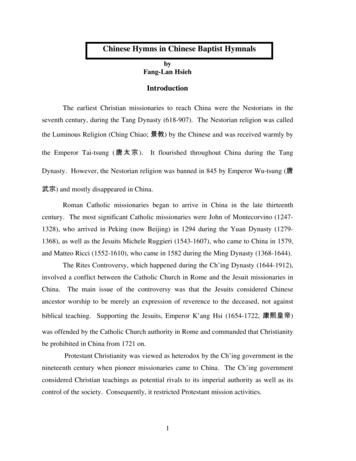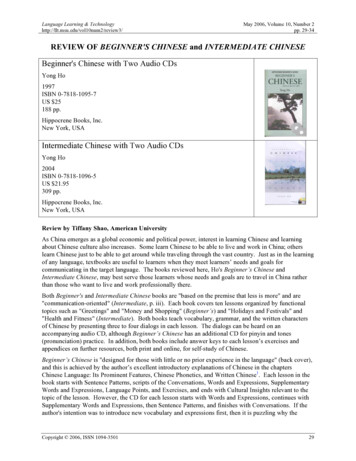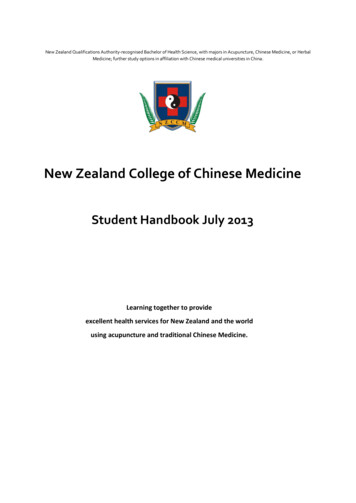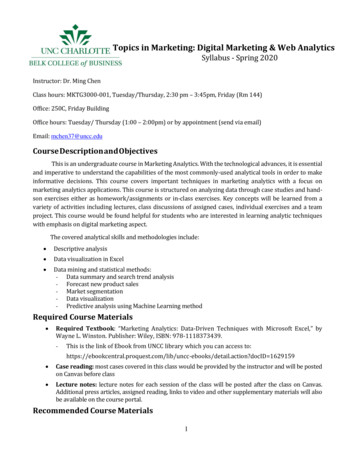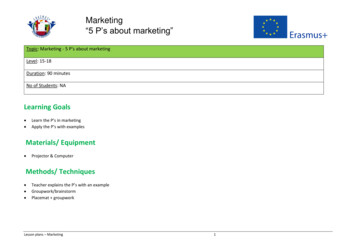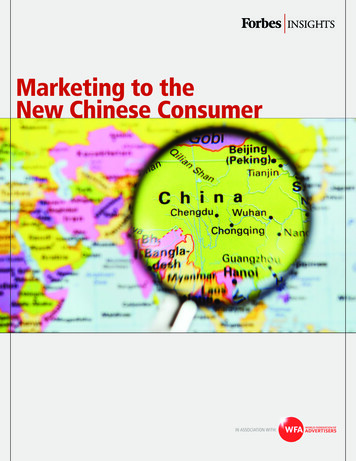
Transcription
Marketing to theNew Chinese Consumerin association with:
Key FindingsTo see how major brands are approaching the emerging Chinese consumer, Forbes Insights, in association withthe World Federation of Advertisers, surveyed more than 300 China-based senior executives at large consumerfocused businesses ( 250M plus in annual revenues) responsible for creating, managing, or executing theircompanies’ marketing strategies in China. The key findings include: Consumer awareness in China is king. About a third of Chinese (35%) and non-Chinese (32%) companiestoday are focused on brand awareness as a key marketing goal for the coming year. Among non-Chinesecompanies, 36% are focused on creating positive brand perception. Marketers will shift from awareness to growth. Three years from now, their top priorities will shift frombrand awareness to increasing sales/revenue from China, and expanding into new regions/areas in China. Global brands must align with local Chinese culture and tastes. The vast majority of non-Chinesemarketers (63%) indicated they believe they need to change their brand attributes for Chinese consumers. Many Chinese brands also are looking to extend their presence beyond their borders. Over aquarter (27%) of Chinese respondents indicated they intend to expand their brands globally. Second-tier cities present the greatest opportunity. Overall, eight of ten respondents agreed thatgrowth is most likely beyond the first-tier cities of Beijing, Shanghai, and Tianjin. As marketers focus on brand development among Chinese consumers, television advertising willplay a large part—79% of respondents have it as part of their marketing programs for 2011. But lookingahead, new platforms may emerge as marketers will be formulating integrated communications strategies. Digital and mobile marketing are a critical part of the mix for reaching Chinese consumers. About90% of survey respondents said they are extremely or very important, especially when it comes tocommunicating with younger consumers. To succeed in China, marketers may need to overcome some unique barriers. These include a lack ofreliable market research, a lack of operational transparency in the Chinese marketing communicationsindustry, and a need to find qualified marketing talent and leadership. Ethical standards for marketing communications need to be put in place in order to protect thereputation of marketing with consumers and government in China over the longer term. Copyright Forbes 20112
introduction:Time for China to Go ShoppingFew markets are as tantalizing to global brand marketers as the new consumer-driven China. The “new” marketof 1.3 billion people—coupled with the meteoric rise of both the size and spending power of its middle class—holds enormous potential for manufacturers of consumer goods and services. But, clearly, the dynamics of Chinaare unlike anything marketers have ever seen before, and it presents challenges as serious as its market is large.Why is China taking off now? Essentially, the government has given the people the right to go shopping. In2011, China begins its 12th five-year plan, shifting its economic focus from export-led sectors to increasing domesticconsumer demand. The plan, passed by the government inmid-March, 2011, is designed to develop the country into amajor consumer marketplace. It plans to increase consumerproduct imports, promote urbanization, and optimize theconsumer market for consumption.That the Chinese consumer is driving global growth iswell known. The statistics are arresting: ten million newChinese consumers enter the market each year. In 2010,China’s consumer market was estimated to be worth 1.7trillion. Credit Suisse projects that the burgeoning domestic consumer market could grow to nearly 16 trillionwithin a decade.But while the consumers are there in droves,brands don’t necessarily know how to reach them.China is still an emerging economy, and marketers often feel they don’t have the research they needto target these new consumers. Furthermore, regionaldifferences across China are pronounced but poorlyunderstood, particularly by foreign firms. And asincomes of Chinese in second-, third-, and fourth-tiercities rise, their consumption patterns will drive market dynamics in unprecedented and unpredictable ways.Consider the following: There are more than 420 million Internet users in China,a number growing by the minute. The advertising andmarketing landscape in China is rapidly changing to adaptto dynamic media and communication technology trends. There are five times as many people in China learningEnglish than there are people living in England. There isan implication here for marketers—the younger generation has a lot of exposure to, not to mention interest in,the West. Copyright Forbes 2011 Chinese consumers spent 9 billion on luxury goods in2010, second only in magnitude to the United States.The consumer in China has become significantly more sophisticated than ever before. Simon Pestridge, globalbrand director for Nike, said, “There is no differencebetween the consumer in China and the consumer in theU.S. They are incredibly proud and savvy, which is different from 10 or 15 years ago.”How, then, are companies finding their way throughthe demographic and marketing wilderness to the promisedland of market share and brand loyalty? Forbes Insights, inassociation with the World Federation of Advertisers, surveyed more than 300 senior executives based in Chinawho work for global or Chinese consumer companies. Allrespondents were responsible for creating, managing, orexecuting their companies’ marketing strategies in China.In surveying a wide range of marketing executives atdomestic and international firms active in China, this reportattempts to sketch out the approaches companies are takingto reach the Chinese consumer. It examines the short- andmid-term goals of consumer brands in China, looks at thetactics companies are using, and identifies some of the critical barriers that marketers will need to overcome.3
Brands for China and BeyondPerception and awarenessAccording to executives responding to the survey, consumer awareness in China is king; raising consumerawareness is one of the three most-frequently cited goalsfor the near- and mid-term. About a third of Chinese (35%)and non-Chinese (32%) companies are focused on brandawareness, making it the most commonly cited marketinggoal for the coming year. (Fig. 1)But brand perception is critical too, and the top focus ofnon-Chinese companies—27% of Chinese companies and36% of non-Chinese companies named positive brand perception as a top marketing goal for the next year.Perception isn’t just some amorphous concept, said SeanLeow, founder of NeochaEDGE, a Shanghai-based creativeagency that connects brands like Coca Cola and AbsolutVodka with Chinese artists for their advertising campaigns.Consumers have to be aware of what your brand stands for,Leow pointed out. When Converse, the shoe company, waslooking to put break into the Chinese market, they madea strategic decision and alliance to associate Converse withmusic. “They ran a campaign called ‘Love Noise,’ wherethey sponsored a few indie rock bands, and they were ableto build up a lot of brand equity,” said Leow.Similarly, Nike has built its marketing and branding strategy around basketball. “As a brand, we have tothink about creating one-on-one relationships with theconsumer,” said Pestridge of Nike. That has meant doingeverything from having Nike-sponsored NBA stars teachbasketball clinics to providing online venues for playersto get tips and information about the sport. “The important thing we can do is to be part of basketball, because inChina basketball is everything,” he said.Brand awareness, however, may be particularly challenging for non-Chinese companies looking to breakinto industries in which there are already hefty domesticcompetitors. The data bears this out: asked to name theirlonger-term marketing goals, the number of respondentsfrom non-Chinese companies selecting “creating positive brand perception” dropped 12 points (from 36% to24%). This suggests that after their initial efforts, awareness trumps perception. (Fig. 2) Copyright Forbes 2011Figure 1: What are your company’s primary marketing goals for China overthe next year?Create positive brand perception3627Increase sales/revenue from China3631Create brand awareness3235Expand into new regions/areas in China3235Develop a sales channel2734Research/learn more about Chinese consumers2624Assess whether our product line is appropriate for China2418Strengthen out position against new competitors2422Create a beachhead for future sales2218Test our ability to compete in China1523Develop a distribution channel15230%50%100% Non-Chinese companies Chinese companies4
Figure 2: What are your company’s primary marketing goals for China overthe next three years?Expand into new regions/areas in China4234Increase sales/revenue from China4235Create brand awareness3438Strengthen out position against new competitors3230Research/learn more about Chinese consumers2420Develop a distribution channel2424Create positive brand perception2425Develop a sales channel2023Test our ability to compete in China1720Create a beachhead for future sales1726Assess whether our product line is appropriate for China9100%50% Non-Chinese companies Chinese companies Copyright Forbes 2011100%Others may be facing an uphill battle regarding perception and awareness. For example, consumer electronicsretailer Best Buy recently announced that it would shutdown its Best Buy-branded stores in China. Instead, ithas chosen to focus on growing Five Star, the domesticChinese chain it acquired in 2006, because Five Star hasachieved greater market penetration and consumer awareness in the Chinese market.Change your brand for China?Best Buy’s shift away from its core brand in China may beindicative of how some non-Chinese brands need to approachthe market. While operating a China-only brand appears notto be the norm, the vast majority of non-Chinese marketers(63%) indicated they believe they need to change their brandattributes for Chinese consumers. (Fig. 3) In many cases, thismay mean altering some brand attributes to demonstratealignment with local Chinese culture and local Chinesetastes. For instance, western spirits brands have had to altertheir scotch marketing to account for Chinese cocktailsthat mix scotch with ice and green tea.That is not to say that strong global brands need a complete brand makeover to compete. The success of manyglobal brands in China would seem to support this: takeStarbucks, McDonald’s, and KFC, for instance. Still, evenif brands don’t need a complete makeover, they might benefit from a few nips and tucks. “Not everyone has to changetheir brand, but they have to show that they ‘get’ the localculture,” said Leow of NeochaEDGE.Pestridge of Nike, agreed. “It’s like any relationship;you have to show an authenticity. If we just broughtKobe Bryant here and did nothing with him thatwouldn’t work,” he said. There is a balancing act thatglobal brands in China must achieve to be successful,to be both a great global brand, but also show commitment and desire to be part of the local culture. Nike haspursued local authenticity in part by creating a Chinafocused e-magazine related to basketball that will bedistributed in Beijing, Shanghai, and Hong Kong. Themagazine is illustrated by local artists and touches onthe many nuances of the basketball scene in China. Onthe actual product side, Nike makes its basketball shoes5
in China with a more durable sole, since basketball isplayed on very hard, abrasive courts.This need for brand flexibility is supported elsewhere inthe survey findings. Two thirds of respondents agreed thatcompanies that are unwilling to change their brands cannotsucceed in China. (Fig. 4)In certain cases, tweaking for a new audience canhelp “uncool” brands re-imagine themselves. Buick isan example of a brand that pulled off a successful makeover: it is one of the most popular automakers in Chinadespite a moribund reputation in its home U.S. market.For the Chinese market, Buick made a few key changes—a more powerful horn, as honking is a favorite pastime inChina, and headlights designed to look more masculineand fierce, two features hardly in keeping with the traditional American Buick.Figure 3: Which of the following best describes how you intend to manageyour brand(s) to Chinese consumers:We will extend our global brand(s) to the Chinese market with the sameattributes we have established in other markets2722We will extend our global brand to the Chinese market, but will change theattributes for China6334We will create a secondary brand unique to the Chinese market210We will extend our China brand(s) to the global market727We only market in ChinaGlobal ambitions for Chinese brandsWhile global brands are eying Chinese consumers, Chinesebrands also are looking to extend their presence beyondtheir borders. Ultimately, the brand competition that isarising in China could quickly spread into the home markets of non-Chinese companies.In the survey, over a quarter (27%) of Chinese respondents indicated they intend to expand their brands globally.For example, Hong-Kong-based Shangri-La Hotels andResorts Group, one of the best-known luxury hotel brandsin China, opened its first European hotel in Paris last year,and hotels in London and Vancouver will anchor international expansion in 2012.“With more and more Chinese travelling overseas,spending more, and looking for venues and destinationsoutside of the traditional Asian countries and lookingfurther to Australia, North America, and Europe, it’s nosurprise that we opened Shangri-La/Paris in December,”said Kent Zhu, director of sales and marketing at theShangri-La Group. Copyright Forbes 2011170%50%100% Non-Chinese companies Chinese companiesFigure 4: Companies that are unw
companies’ marketing strategies in China. The key findings include: Consumer awareness in China is king. About a third of Chinese (35%) and non-Chinese (32%) companies today are focused on brand awareness as a key marketing goal for the coming year. Among non-Chinese companies, 36% are focused on creating positive brand perception.


